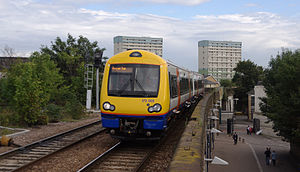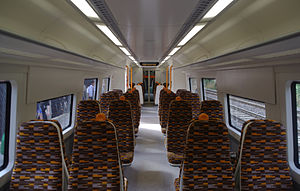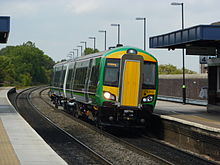- British Rail Class 172
-
British Rail Class 172 Turbostar 
London Overground unit 172005 approaches Leytonstone High Road on the Gospel Oak to Barking Line
The interior of London Overground unit 172005.In service 10 July 2010 - Present Manufacturer Bombardier Transportation Family name Turbostar Constructed 2010 - Number built 39 trainsets ordered Formation 2 or 3 cars per trainset Capacity 172/0: 120 seats
172/1: ? seats
172/2: 116 seats
172/3: 188 seatsOperator London Overground
Chiltern Railways
London MidlandLine(s) served Snow Hill Lines
Chiltern Main Line
Chase Line
Gospel Oak to Barking LineSpecifications Car body construction Welded aluminium. Steel ends. Car length 23.62 m (77 ft 6 in) Width 2.69 m (8 ft 10 in) Height 3.77 m (12 ft 4 in) Maximum speed 172/0: 75 mph (120 km/h)
172/1, 172/2 and 172/3 - 100 mph (160 km/h)Engine(s) One per car, 485hp
MTU 6H1800R83 DieselTransmission ZF Ecomat-Rail 6 speed
ZF Reversing final driveSafety system(s) AWS, TPWS (172/1 will additionally have ATP) Gauge 1,435 mm (4 ft 8 1⁄2 in) Standard gauge The Class 172 is a type of diesel multiple unit (DMU) of the Turbostar family, similar to the Class 168, Class 170 and Class 171.
Contents
Technical details and variants
There will be four sub-types:
- Class 172/0 - two-car units in operation with London Overground
- Class 172/1 - two-car units to be operated by Chiltern Railways
- Class 172/2 - two-car units in operation with London Midland
- Class 172/3 - three-car units in operation with London Midland
The 172/0s and 172/1s resemble the existing Turbostar trains in not having end gangways. Class 172/0s have a top speed of 75 mph (120 km/h) due to their use on the high volume/short distance services, such as those on the Gospel Oak to Barking Line. Class 172/1s have a maximum speed of 100mph.
The Class 172/2s and 172/3s used by London Midland resemble the Class 375, Class 377 and Class 379 Electrostars by having end gangways to allow access between units.[1] These trains have a maximum speed of 100 mph (160 km/h).[2]
The Class 172 trains are lighter than other Turbostars thanks to the addition of lightweight bogies similar to those on the Class 220 Voyager trains.[3] They also differ from earlier Turbostars in having mechanical transmission rather than hydraulic - gear changes can be distinctly heard as the trains accelerate and decelerate.
Differences from Class 150
Class 172s have fewer seats than the Class 150s they replace[2], but greater overall capacity due to the increased room for standing passengers as well as wider aisles intended to speed boarding and alighting and reduce waiting time in stations. The trains are air conditioned and have no openable windows, unlike the Class 150s.
Operators
London Overground
London Overground operates eight two-car Class 172s on the Gospel Oak to Barking Line, replacing the old Class 150 stock. The units were originally meant to be in service from February 2010,[4] but due to production issues and then what were thought to be exhaust problems (which proved to be a false alarm),[5] the trains entered service only in July 2010; and then at reduced capacity due to staff training problems. By December 2010 the whole fleet was in service, allowing the Class 150s to be cascaded to First Great Western and other operators. The units are leased by London Overground Rail Operations Ltd (LOROL), the London Overground concession operator, from a rolling stock leasing company rather than them being purchased directly by Transport for London.[6]
London Midland
London Midland will operate a total of 27 two-car and three-car units, originally planning for them to enter service by the end of 2010 on services to and from Birmingham Snow Hill, again replacing Class 150s.[7] The London Midland sets have end gangways which make the trains look like the Electrostar Classes 375, 377 and 379.
As of 31 August 2011 the following sets are at Tyseley and Worcester for mileage running and driver training. 172331, 332, 333, 337, 338, 339, 340, 341, 343, 344, 345. 3-car units. 172211, 172213, 214, 215, 217 2-car units.
331 and 332 are currently at Derby having interiors fitted. [8]
From 1 September 2011, the first two diagrams began to be operated by the new Class 172 units.[9]
Chiltern Railways
Chiltern Railways has obtained four two-car trains in the same order as that of London Overground to supplement the current Class 165 Networker Turbos on its routes from London Marylebone, originally due to be delivered from late 2010. These trains differ from the London Overground units with the addition of the ATP safety system, to make them compatible with the rest of the Chiltern fleet.[10] They do not have the tripcock safety system installed—unlike the rest of the Chiltern Railways fleet—as the design of the bogie being used (based on the B5005 found on Class 220 Voyager and Class 222 Meridian trains) means there is no place for the brackets to be mounted. Thus, they are not be able to operate on the Aylesbury via Amersham line whilst the current signalling system is in place unless running in multiple with other units on both the front and rear ends, which are fitted with a tripcock.
Introduction into service
London Midland unit 172213 passes Tamworth High Level en-route from Derby Litchurch Lane
In late 2007 and early 2008, orders were placed with Bombardier by two rolling-stock leasing companies to purchase a number of Class 172 Turbostar trains. In December 2007, Porterbrook ordered 15 three-car and 12 two-car trains for London Midland for delivery in 2010. In January 2008, Angel Trains, on behalf of London Overground and Chiltern Railways, ordered 12 two-car trains for delivery, which would have been delivered during 2009.[11] However, difficulties encountered by Bombardier over the deliveries by its suppliers led to delays in filling the Class 377 and 378 Electrostar orders, with subsequent knock-on delays for building the Class 172 sets. Work began at the end of 2009 after the freeing-up of one of Bombardier's production lines following completion of the Class 377 order for First Capital Connect.[12]
Eight 172/0 units have been built for London Overground. Testing of the first batch of new units, the 172/0 sets for London Overground, commenced in March 2010, with two sets (anonymous as they did not have unit numbers on them) being tested on the Old Dalby Test Track.[13] All units have subsequently been delivered to Willesden Train Maintenance Depot (TMD).
All eight 172/0 units have entered service for London Overground. These were originally restricted to a top speed of 40 miles per hour (64 km/h) as opposed to their intended design speed of 75 miles per hour (121 km/h),[14] as it was thought there was a fault with the exhaust system requiring modifications to the original design and the already procured units. It was expected that units for London Midland and Chiltern would be delayed by a further 6–12 months.[15] However, it transpired that the exhaust emission testing had been flawed and that there were no major problems with the units or the original design. Production therefore continued as planned with a slight delay.[5]
The four Chiltern Railways units entered service during summer 2011.[citation needed]
Fleet details
Class Operator Number built Year built Cars per set Unit nos. Class 172/0[16] London Overground 8 2010 2 172001-172008[17] Class 172/1[18] Chiltern Railways 4 2011 172101-172104[17] Class 172/2[19] London Midland 12 2011 - 172211-172222[17] Class 172/3[19] 15 3 172331-172345[17] Further potential orders
As part of its franchise agreement, London Midland has an option to purchase an additional 26 Class 172 vehicles which could potentially allow further cascade of its existing rolling stock.[20]
In 2008, First Great Western applied to the Department for Transport to re-equip its Cardiff to Portsmouth via Bristol services with 11 new four-car DMUs which would potentially allow the existing Class 158 Express Sprinter trains to be transferred to other services. According to the West of England Partnership, these were likely to be "similar to Class 170s", suggesting that they might be Class 172 Turbostars.[21]
The Government announced in December 2008 that Bombardier, with its Turbostar design, was one of the pre-qualified bidders (along with CSR of China, CAF of Spain and Rotem of South Korea) for the first 200 DMU vehicles of its planned 1300 new carriages.[22] These new trains were intended for use on suburban and inter-urban services operated by First Great Western, First TransPennine Express and Northern Rail. However, with the announcement of the electrification schemes in the North West and on the Great Western Main Line, the DMU order was cancelled, with the needs of the train operating companies planned to be met by transfers of existing stock.
Bombardier offered the Class 172 Turbostar to NI Railways for its "New Trains Two" specification, eventually losing out to CAF and a variation of NIR's existing Class 3000.[23]
References
- ^ "London Midlands Class 172/3 DMU, 172331, 5Z72 Derby Litchurch Lane - Old Dalby". Published Railways Illustrated Issue March 2011. http://cw-railpic.fpic.co.uk/p68624467.html.
- ^ a b Class 172 Technical Data
- ^ Gospel Oak to Barking improvement details.
- ^ "New Plans". The Barking - Gospel Oak Line User Group. http://www.barking-gospeloak.org.uk/temp_page2.htm.
- ^ a b Ford, Roger (December 2010). "Bombardier recovering from multiple-unit hiccups". Modern Railways (London): pp. 32–33.
- ^ "The Underground Roundel moves Overground". Today's Railways (UK) (Sheffield) (70): 24–30. September 2007.
- ^ "Bombardier to supply 69 Turbostar cars to Porterbrook Leasing in 129 million euro contract for the UK" (Press release). Porterbrook. 13 December 2007. http://www.porterbrook.com/pages/press_releases/131207.html. Retrieved 5 July 2008.
- ^ Old Dalby: Test runs of the LM Class 172. Retrieved 2 February 2011.
- ^ "London Midland launches £93m train fleet for Snow Hill line" (Press release). London Midland. 2 September 2011. http://www.londonmidland.com/news/latest-news/london-midland-launches-93m-train-fleet-for-snow-hill-line/.
- ^ "Angel Trains orders 'green trains' for the UK rail market" (Press release). Angel Trains. 31 January 2008. http://www.angeltrains.co.uk/press/release.aspx?Id=692.
- ^ "Class 172s ordered". Today's Railways (UK) (Sheffield) (74): pp. 56–58. January 2008.
- ^ 377/5 delays and its impact - London's Transport
- ^ Photos of the class 172s under test.
- ^ Miles, Tony (August 2010). "Class 172 ready for introduction". Modern Railways (London) (743): p. 75.
- ^ Modern Railways (741). July 2010.
- ^ "Transport for London signs new train leasing contract". Transport for London. 20 February 2008. http://www.tfl.gov.uk/corporate/media/newscentre/archive/7525.aspx.
- ^ a b c d Clinnick, Richard (2009). "Britain's future-facing fleets". Rail (634): 66–73.
- ^ "East-West Rail Scheme, United Kingdom". Railway Technology. http://www.railway-technology.com/projects/east-westlink/.
- ^ a b "Twenty seven new trains for London Midland". London Midland. 13 December 2007. http://www.londonmidland.com/news/latest-news/news-archive/2007/12/twenty-seven-new-trains-for-london-midland/.
- ^ "ROSCO Inquiry: DfT raises the stakes". Modern Railways: 25–26. November 2008.
- ^ Cardiff to Portsmouth New Trains Bid - West of England Partnership
- ^ "Invitation to tender issued for 200 new diesel train carriages" (Press release). Department for Transport. 22 December 2008. http://nds.coi.gov.uk/environment/fullDetail.asp?ReleaseID=388266&NewsAreaID=2.
- ^ Flanagan, Colm (2010). "Optimism in Northern Ireland". Modern Railways 67 (737): pp. 60–64.
Bombardier Turbostar and Electrostar family Turbostar family: Electrostar family: Diesel multiple units of the United Kingdom First generation units: First Generation
Original TOPS:First generation units
(pre-TOPS):British United Traction · Derby Lightweight · Metro-Cammell · Railbus · GWR Railcars · LMS Railcars
Second generation units: Diesel-electric units: Southern Railway designations: Families Categories:- Bombardier multiple units
- British Rail diesel multiple units
- London Overground
Wikimedia Foundation. 2010.

